Assessment of a Bionic Broach Implanted with Nylon Fibers
Abstract
1. Introduction
2. Experiment and Method
2.1. Bionics Principle
2.2. The Selection of Broach and Workpiece
2.3. The Preparation of the Flocked Broach
2.4. Broaching Experimental Settings
2.5. Wettability and Spreading Experiment
3. Modeling of the Friction Coefficient of the Bionic Broach
4. Results and Discussion
4.1. Influence of Tool Surfaces on the Broaching Force
4.1.1. Broaching Force
4.1.2. Broaching Mechanism of Flocked Tools
4.2. Influence of Different Tool Surfaces on Chip Morphology
4.2.1. Chip Curl
4.2.2. Chip Morphology
4.3. Influence of Different Tools on Surface Quality
4.3.1. Surface Quality of the Workpiece
4.3.2. Broaching Vibration of Different Tool Surfaces
5. Conclusions
- (1)
- Flocked broaches can effectively reduce the cutting force (Fc), positive pressure (Ft), and coefficient of friction (COF) due to their superior lubrication ability, when compared to the unflocked broach (NB). The maximum reductions are 16.82%, 24.41%, and 6.07%. Furthermore, a modified analytical model with less than 5.6% error indicates that by combining the flocking area with lubricant, the COF can be predicted more accurately.
- (2)
- Because the fluff on the rake face improves lubricant absorption and the ability to store and sweep microchips, flocked broaches can improve chip curling and increase the shear angle, making it easier to achieve the purpose of chip breaking than with an NB, with a maximum increase in the shear angle of approximately 6.92%.
- (3)
- Flocked broaches can significantly improve machined quality and reduce surface roughness. The reason for this is that they can suppress the excitation vibration generated during the broaching process, improving chip formation stability and continuity.
- (4)
- FB2 has the best broaching performance of any broach due to its appropriate flocking area and spacing. The coating sizes of flocked surfaces below or above this threshold will cause a deterioration of the broaching performance.
Author Contributions
Funding
Institutional Review Board Statement
Informed Consent Statement
Data Availability Statement
Conflicts of Interest
References
- Ni, J.; Cui, Z.; He, L.; Yang, Y.; Sang, Z.; Rahman, M. Reinforced lubrication of vegetable oils with nano-particle additives in broaching. J. Manuf. Process. 2021, 70, 518–528. [Google Scholar] [CrossRef]
- Xiao, A.; Huang, C.; Cui, X.; Yan, Z.; Yu, Z. Impact of the pulse induced current on the microstructure and mechanical properties of the 7075-T6 aluminum alloy. J. Alloys Compd. 2022, 911, 16502. [Google Scholar] [CrossRef]
- Ni, J.; Cui, Z.; Wu, C.; Sun, J.; Zhou, J. Evaluation of MQL broaching AISI 1045 steel with sesame oil containing nano-particles under best concentration. J. Clean. Prod. 2021, 320, 128888. [Google Scholar] [CrossRef]
- Nyaboro, J.; Ahmed, M.; El-Hofym, H.; El-Hofy, M. Experimental and numerical investigation of the abrasive waterjet machining of aluminum-7075-T6 for aerospace applications. Adv. Manuf. 2021, 9, 286–303. [Google Scholar] [CrossRef]
- Mishra, S.K.; Ghosh, S.; Aravindan, S. Machining performance evaluation of Ti6Al4V alloy with laser textured tools under MQL and nano-MQL environments. J. Manuf. Process. 2020, 53, 174–189. [Google Scholar] [CrossRef]
- Ahmed, Y.S.; Paiva, J.M.; Arif, A.F.M.; Amorim, F.L.; Torres, R.D.; Veldhuis, S.C. The effect of laser micro-scale textured tools on the tool-chip interface performance and surface integrity during austenitic stainless-steel turning. Appl. Surf. Sci. 2020, 510, 145455. [Google Scholar] [CrossRef]
- Picavea, J.; Gameros, A.; Yang, J.; Axinte, D. Vibration suppression using tuneable flexures acting as vibration absorbers. Int. J. Mech. Sci. 2022, 222, 107238. [Google Scholar] [CrossRef]
- Ye, Z.; Wang, Y.G.; Yu, X. Study on the reaming process of aluminum alloy7050-T7451 under different cooling conditions. Adv. Manuf. 2022, 10, 272–286. [Google Scholar] [CrossRef]
- Hao, X.; Cui, W.; Li, L.; Li, H.; Khan, A.M.; He, N. Cutting performance of textured polycrystalline diamond tools with composite lyophilic/lyophobic wettabilities. J. Mater. Process. Technol. 2018, 260, 1–8. [Google Scholar] [CrossRef]
- Siju, A.S.; Gajrani, K.K.; Joshi, S.S. Dual textured carbide tools for dry machining of titanium alloys. Int. J. Refract. Met. Hard Mater. 2021, 94, 105403. [Google Scholar] [CrossRef]
- Pratap, A.; Patra, K. Combined effects of tool surface texturing.; cutting parameters and minimum quantity lubrication (MQL) pressure on micro-grinding of BK7 glass. J. Manuf. Process. 2020, 54, 374–392. [Google Scholar] [CrossRef]
- Guo, B.; Zhang, J.; Wu, M.; Zhao, Q.; Liu, H.; Monier, A.; Wang, J. Water assisted pulsed laser machining of micro-structured surface on CVD diamond coating tools. J. Manuf. Process. 2020, 56, 591–601. [Google Scholar] [CrossRef]
- Sui, X.; Li, G.; Jiang, C.; Gao, Y.; Wang, K.; Wang, Q. Improved surface quality of layered architecture TiAlTaN/Ta coatings for high precision micromachining. Surf. Coat. Technol. 2017, 320, 298–303. [Google Scholar] [CrossRef]
- Malakizadi, A.; Hajali, T.; Schulz, F.; Cedergren, S.; Ålgårdh, J.; M’Saoubi, R.; Hryha, E.; Krajnik, P. The Role of Microstructural Characteristics of Additively Manufactured Alloy 718 on Tool Wear in Machining. Int. J. Mach. Tools Manuf. 2021, 171, 103814. [Google Scholar] [CrossRef]
- Ao, N.; Liu, D.; Zhang, X.; Fan, K.; Shi, H.; Liu, Z.; Liu, C. The effect of residual stress and gradient nanostructure on the fretting fatigue behavior of plasma electrolytic oxidation coated Ti-6Al-4V alloy. J. Alloy. Compd. 2019, 811, 152017. [Google Scholar] [CrossRef]
- Zhou, X.; Wang, K.; Li, C.; Wang, Q.; Wu, S.; Liu, J. Effect of ultrafine gradient cemented carbides substrate on the performance of coating tools for titanium alloy high speed cutting. Int. J. Refract. Met. Hard Mater. 2019, 84, 105024. [Google Scholar] [CrossRef]
- Lü, W.; Li, G.; Zhou, Y.; Liu, S.; Wang, K.; Wang, Q. Effect of high hardness and adhesion of gradient TiAlSiN coating on cutting performance of titanium alloy. J. Alloys Compd. 2020, 820, 153137. [Google Scholar] [CrossRef]
- Xiong, Y.; Wang, W.; Jiang, R.; Lin, K. Machinability of in situ TiB2 particle reinforced 7050Al matrix composites with TiAlN coating tool. Int. J. Adv. Manuf. Technol. 2018, 97, 3813–3825. [Google Scholar] [CrossRef]
- Liu, C.; Liu, Z.; Wang, B. Modification of surface morphology to enhance tribological properties for CVD coated cutting tools through wet micro-blasting post-process. Ceram. Int. 2018, 44, 3430–3439. [Google Scholar] [CrossRef]
- Zhou, H.; Wang, C.; Guo, Q.; Yu, J.; Wang, M.; Liao, X.; Ren, L. Influence of processing medium on frictional wear properties of ball bearing steel prepared by laser surface melting coupled with bionic principles. J. Alloys Compd. 2010, 505, 801–807. [Google Scholar] [CrossRef]
- Li, C.; Ma, R.; Du, A.; Fan, Y.; Zhao, X.; Cao, X. One-step fabrication of bionic superhydrophobic coating on galvanised steel with excellent corrosion resistance. J. Alloys Compd. 2019, 786, 272–283. [Google Scholar] [CrossRef]
- Wenqing, D.; Dazhong, W.; Guoqing, C. Mechanism of an approach based on bone microstructure to improve the machining quality for bionic multi-size particulate-reinforced composite. Compos. Struct. 2021, 274, 114346. [Google Scholar] [CrossRef]
- Liu, C.; Liu, Q.; Jin, R.; Lin, Z.; Qiu, H.; Xu, Y. Mechanism analysis and durability evaluation of anti-icing property of superhydrophobic surface. Int. J. Heat. Mass. Tran. 2020, 156, 119768. [Google Scholar] [CrossRef]
- Babu, K.F.; Masoud, H.; Karolina, P.M. The Manufacture of Unbreakable Bionics via Multifunctional and Self-Healing Silk-Graphene Hydrogels. Adv. Mater. 2021, 33, 2170276. [Google Scholar] [CrossRef]
- Zhang, W.; Zhang, L.; Wang, B.; Wang, S. Finite element simulation analysis of bionic ball-end milling cutter. Int. J. Adv. Manuf. Technol. 2019, 103, 3151–3161. [Google Scholar] [CrossRef]
- Zheng, L.; Wu, J.; Zhang, S. Bionic coupling of hardness gradient to surface texture for improved anti-wear properties. J. Bionic Eng. 2016, 13, 406415. [Google Scholar] [CrossRef]
- Tong, J.; Xu, S.; Chen, D.; Li, M. Design of a Bionic blade for Vegetable Chopper. J. Bionic Eng. 2017, 14, 163–171. [Google Scholar] [CrossRef]
- Siju, A.; Waigaonkar, S. Effects of Rake Surface Texture Geometries on the Performance of Single-Point Cutting Tools in Hard Turning of Titanium Alloy. J. Manuf. Process. 2021, 69, 235–252. [Google Scholar] [CrossRef]
- Fabbrocino, F.; Carpentieri, G. Three-dimensional modeling of the wave dynamics of tensegrity lattices. Compos. Struct. 2017, 173, 9–16. [Google Scholar] [CrossRef]
- Lee, E.H.; Shaffer, B.W. The theory of plasticity applied to a problem of machining. J. Appl. Mech. 1951, 18, 405–413. [Google Scholar] [CrossRef]
- Mancusi, G.; Fabbrocino, F.; Feo, L.; Fraternali, F. Size effect and dynamic properties of 2D lattice materials. Compos. Part B Eng. 2017, 112, 235–242. [Google Scholar] [CrossRef]
- Wenzel, R.N. Resistance of solid surfaces to wetting by water. Ind. Eng. Chem. 1936, 28, 988–994. [Google Scholar] [CrossRef]
- Pei, H.; Liu, H.; Zhu, Y.; Lu, Z. Understanding the Wettability of a Hairy Surface: Effect of Hair Rigidity and Topology. Phys. Chem. Chem. Phys. 2016, 18, 18767–18775. [Google Scholar] [CrossRef] [PubMed]
- Ni, J.; Feng, K.; Zhao, H. Wettability enhancement of high-speed steel surface with electrostatic flocking method. Colloid Surf. A 2022, 651, 129781. [Google Scholar] [CrossRef]
- Duan, R.; Deng, J.; Ai, X.; Liu, Y.; Chen, H. Experimental Assessment of Derivative Cutting of Micro-Textured Tools in Dry Cutting of Medium Carbon Steels. Int. J. Adv. Manuf. Technol. 2017, 92, 3531–3540. [Google Scholar] [CrossRef]
- Axinte, D.A. An Experimental Analysis of Damped Coupled Vibrations in Broaching. Int. J. Mach. Tools Manuf. 2007, 47, 2182–2188. [Google Scholar] [CrossRef]
- Toh, C.K. Vibration Analysis in High Speed Rough and Finish Milling Hardened Steel. J. Sound Vib. 2004, 278, 101–115. [Google Scholar] [CrossRef]
- Rotella, G. Effect of Surface Integrity Induced by Machining on High Cycle Fatigue Life of 7075-T6 Aluminum Alloy. J. Manuf. Process. 2019, 41, 83–91. [Google Scholar] [CrossRef]
- Ping, Z.; Xiujie, Y.; Penghao, W.; Xiao, Y. Surface Integrity and Tool Wear Mechanism of 7050-T7451 Aluminum Alloy under Dry Cutting. Vacuum 2021, 184, 109886. [Google Scholar] [CrossRef]
- Jung, H.; Hayasaka, T.; Shamoto, E.; Ishii, H.; Ueyama, T.; Hamada, S. “Multimode Vibration Cutting”—A New Vibration Cutting for Highly-Efficient and Highly-Flexible Surface Texturing. Precis. Eng. 2021, 72, 111–121. [Google Scholar] [CrossRef]
- Xie, J.; Luo, M.; Wu, K.; Yang, L.; Li, D. Experimental study on cutting temperature and cutting force in dry turning of titanium alloy using a non-coated micro-grooved tool. Int. J. Mach. Tools Manuf. 2013, 73, 25–36. [Google Scholar] [CrossRef]
- Klocke, F.; Nobel, C.; Veselovac, D. Influence of Tool Coating, Tool Material, and Cutting Speed on the Machinability of Low-Leaded Brass Alloys in Turning. Mater. Manuf. Process. 2016, 31, 1895–1903. [Google Scholar] [CrossRef]
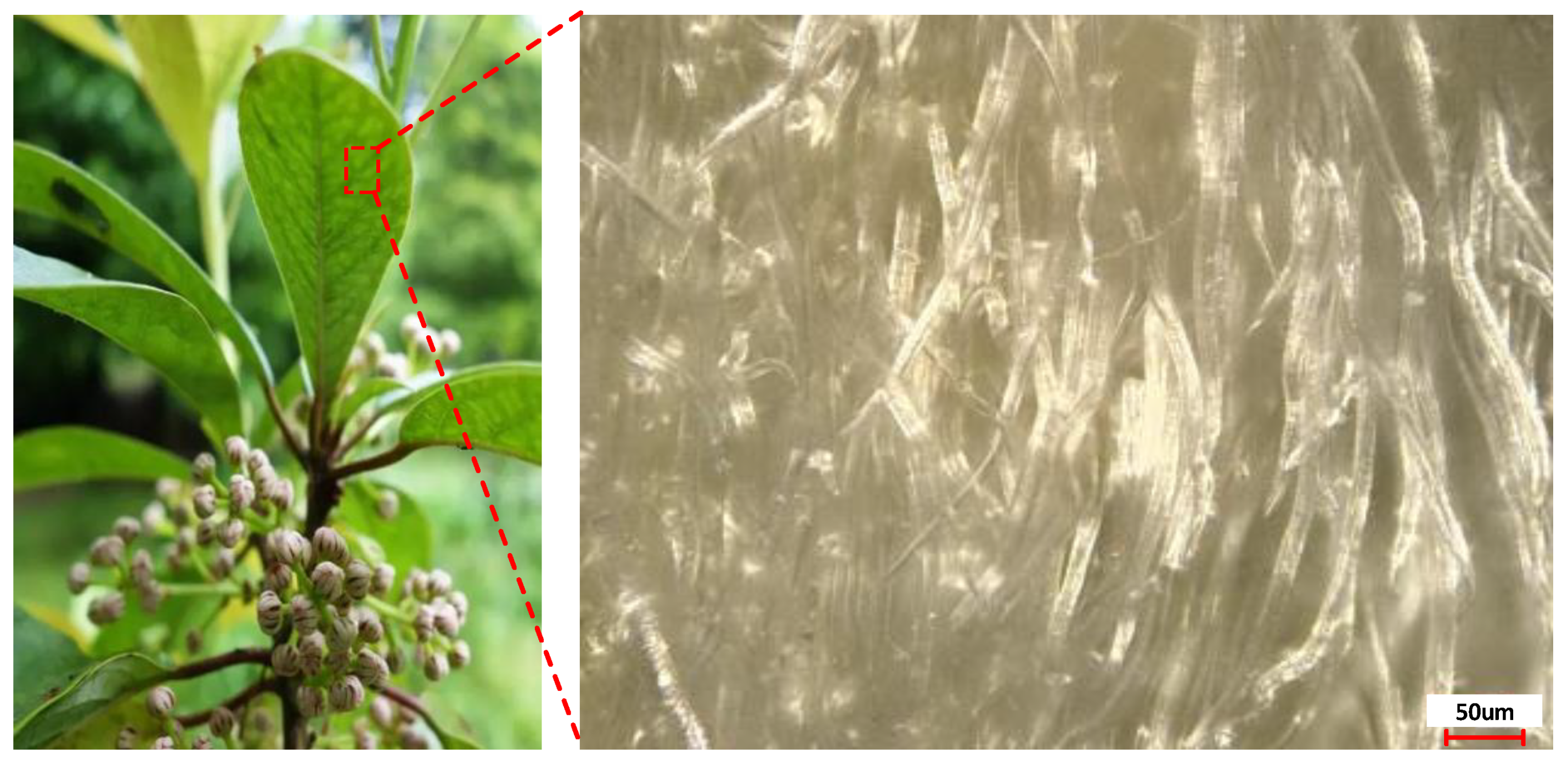

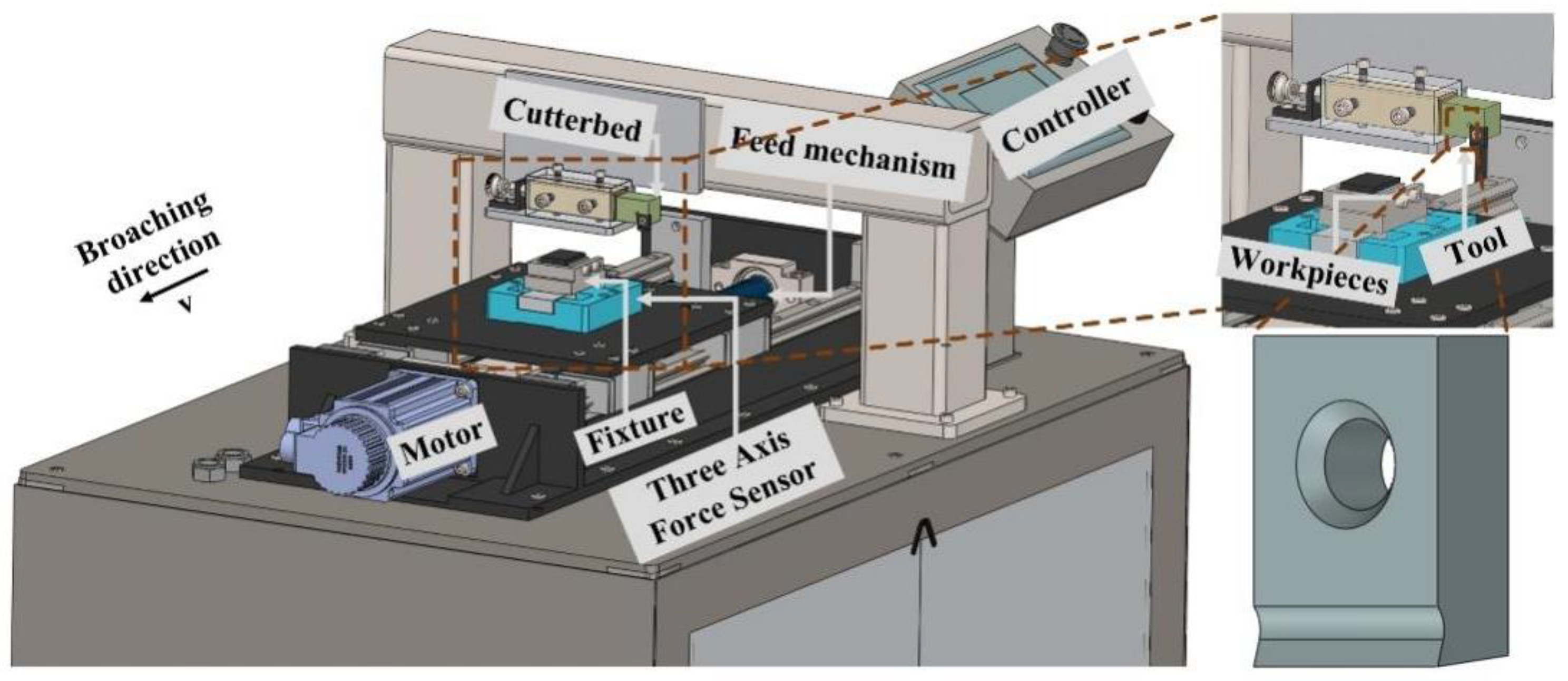
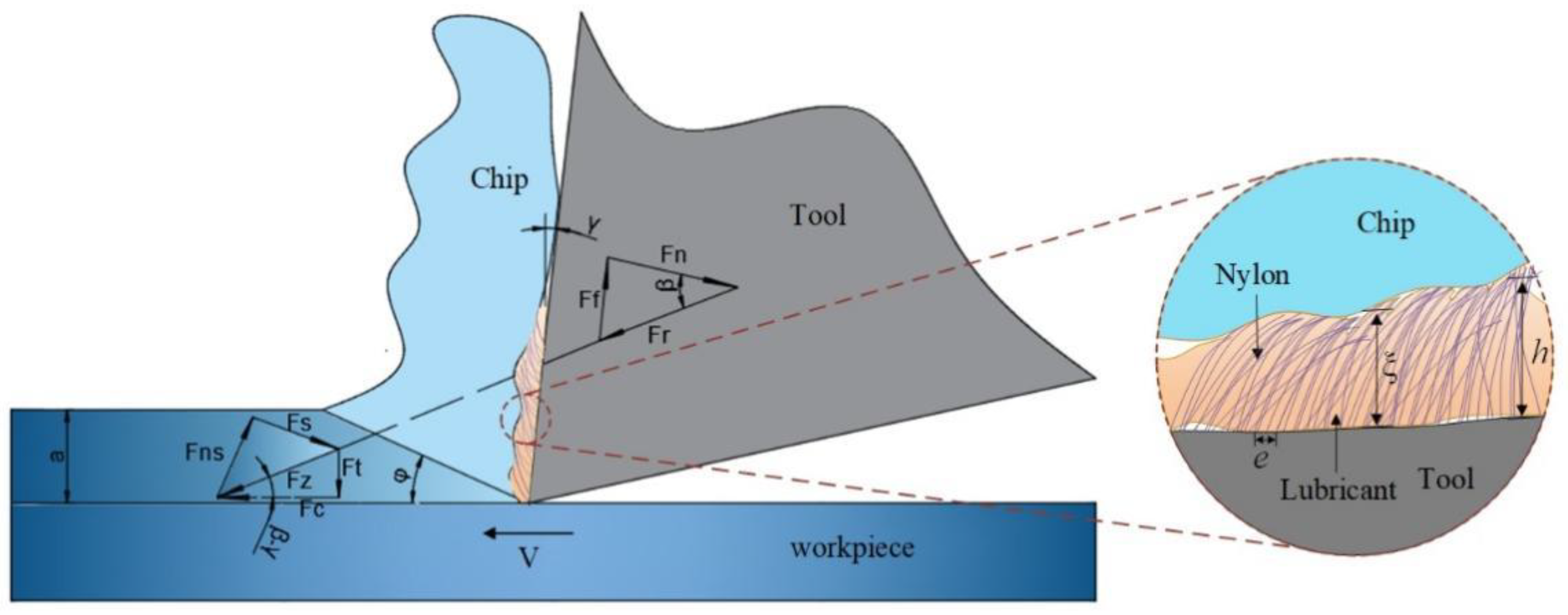
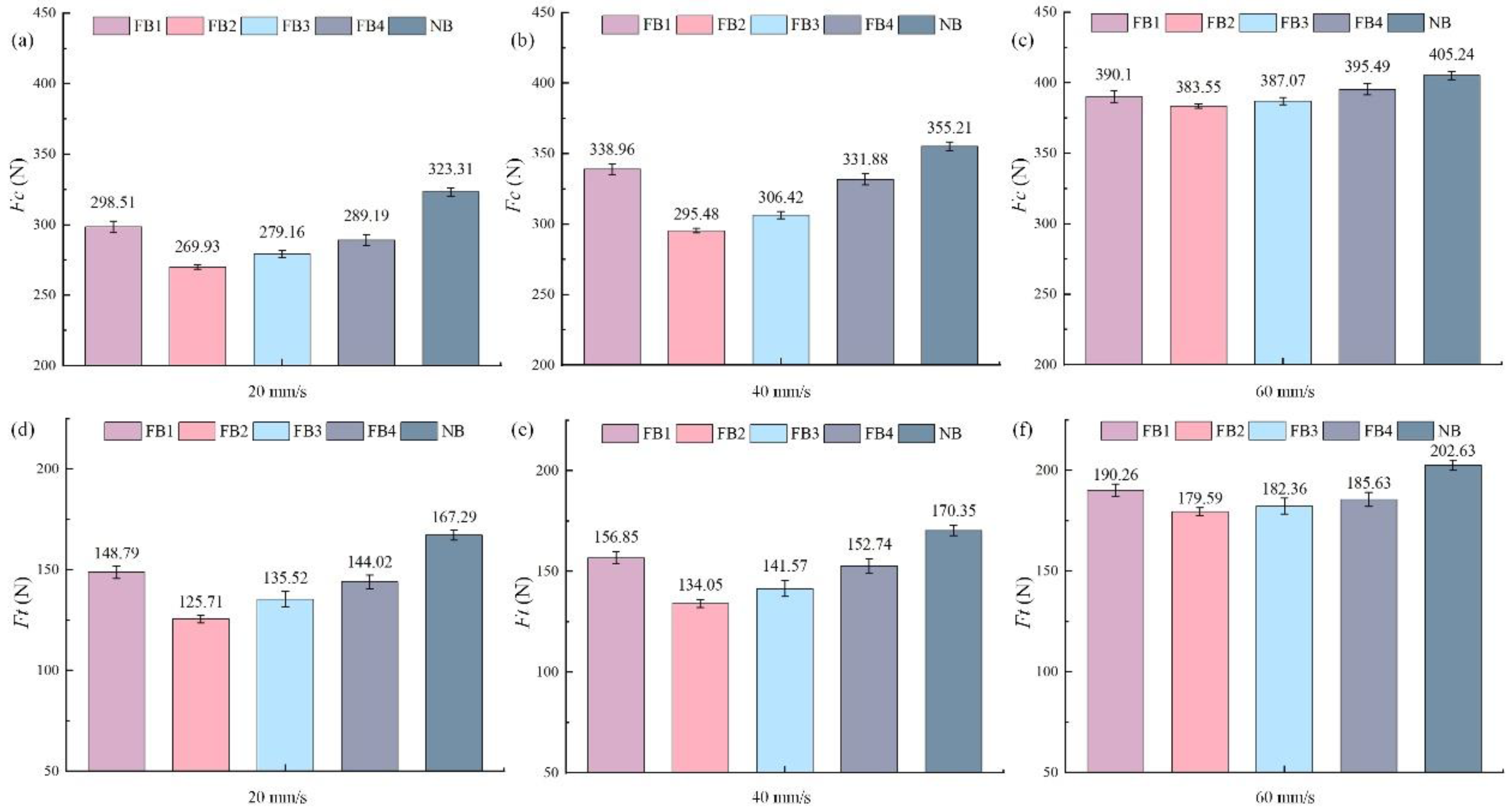
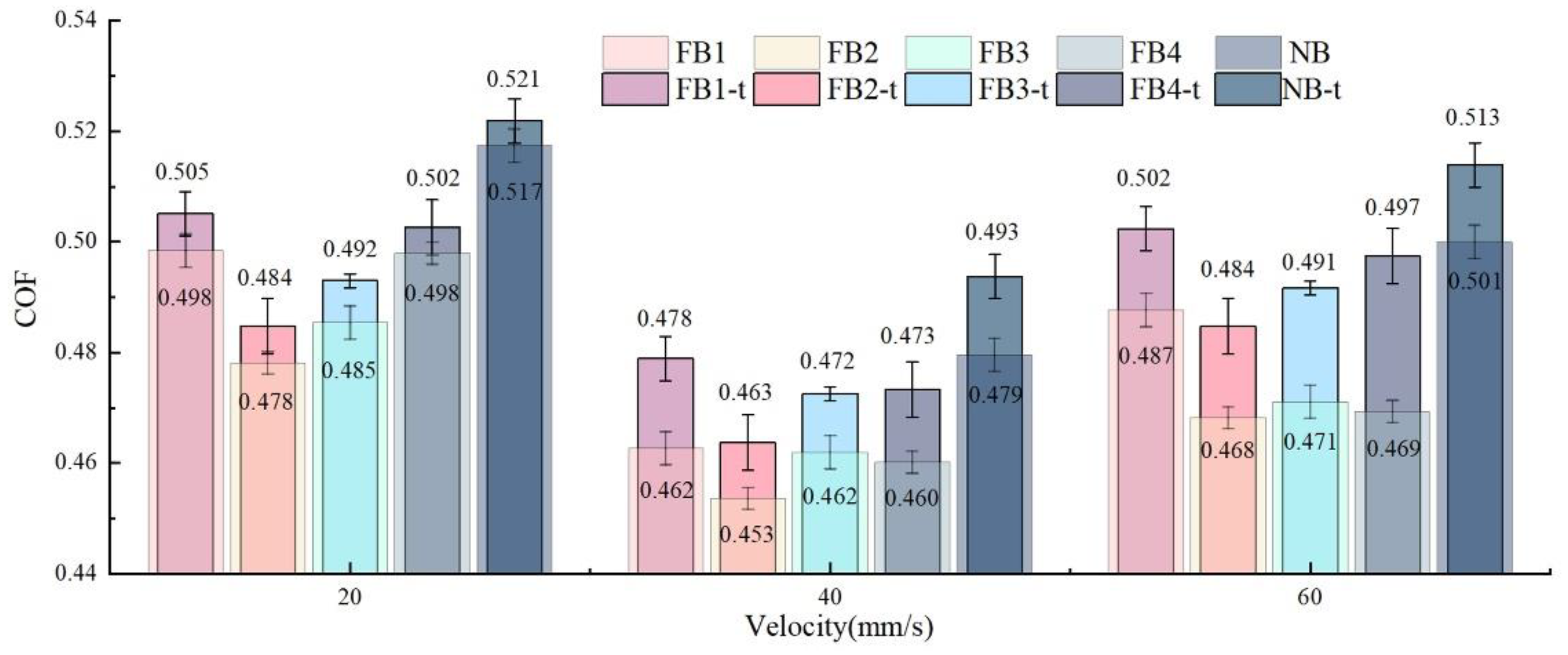
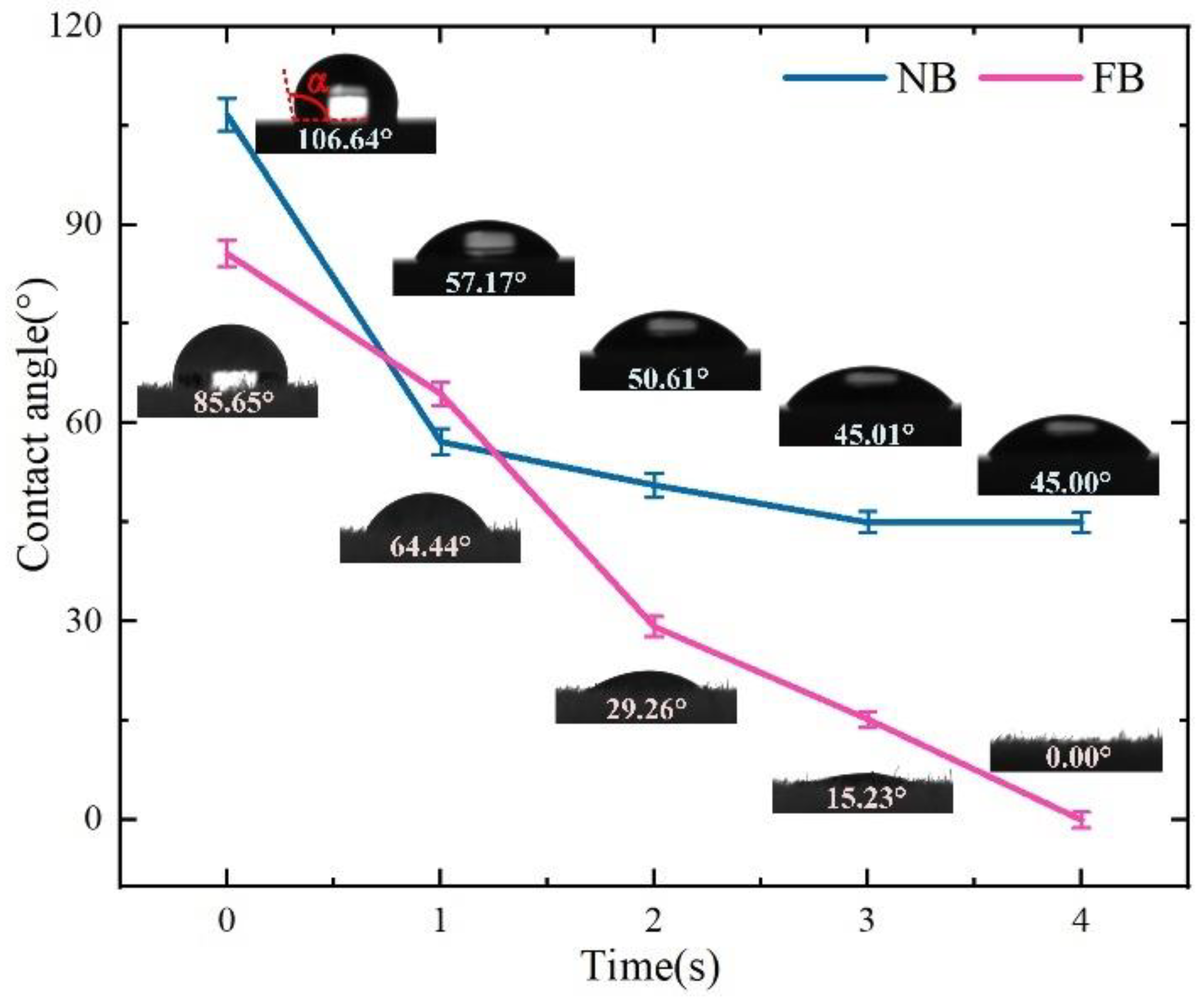
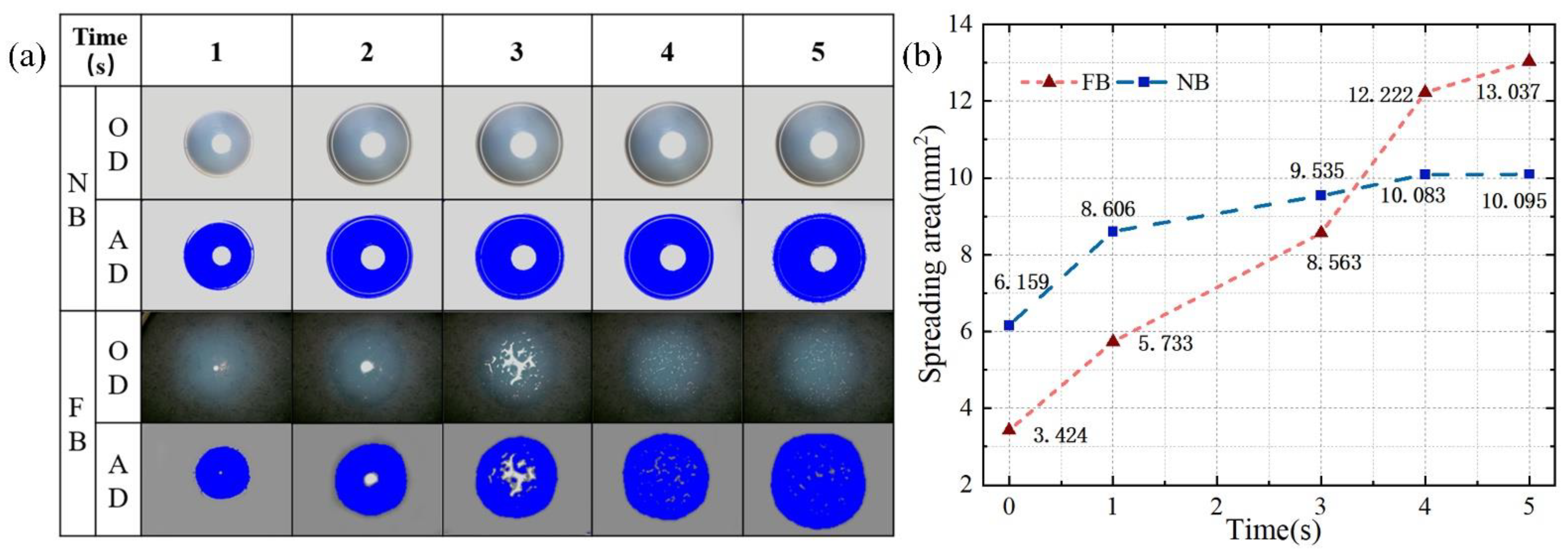
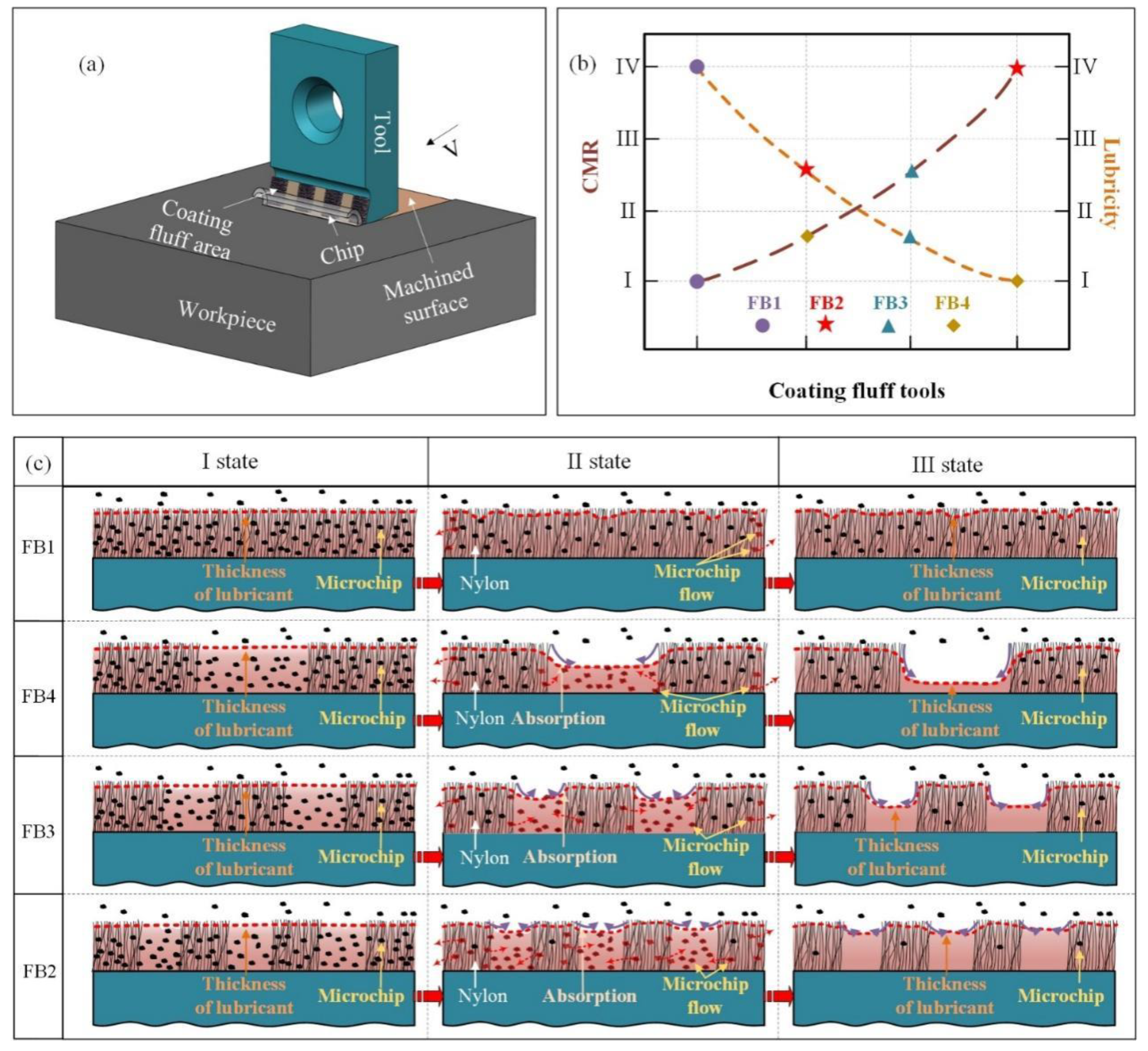

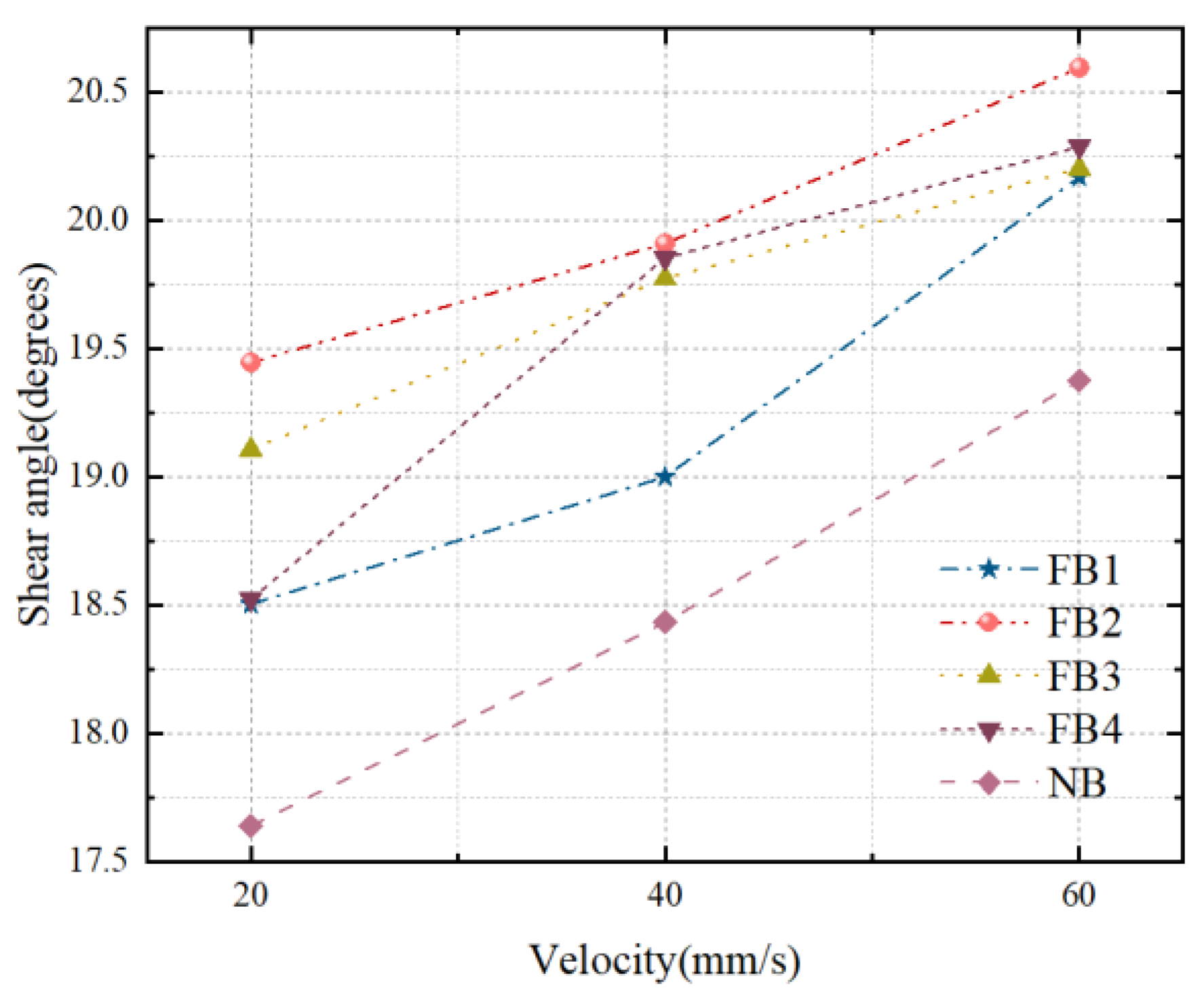

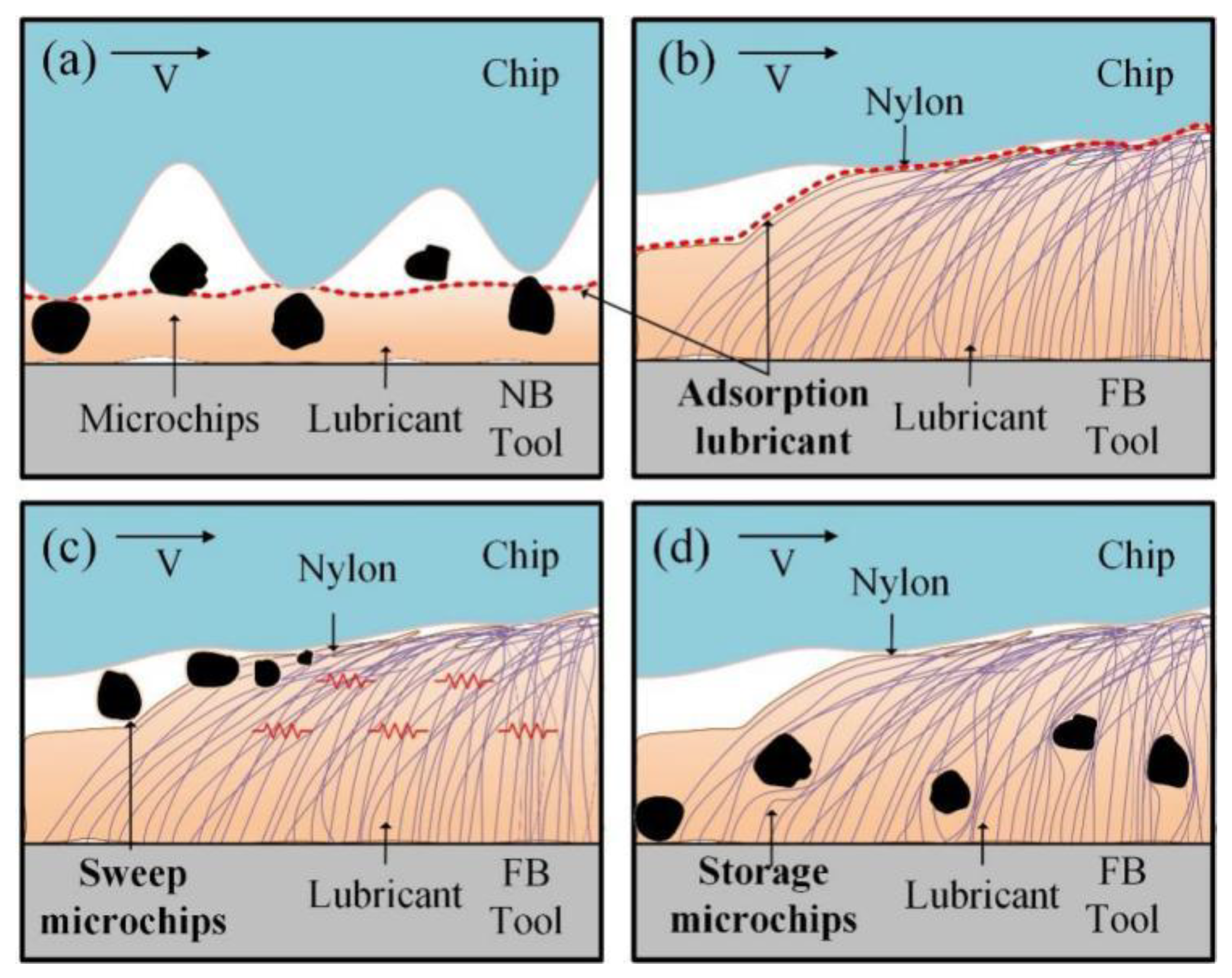


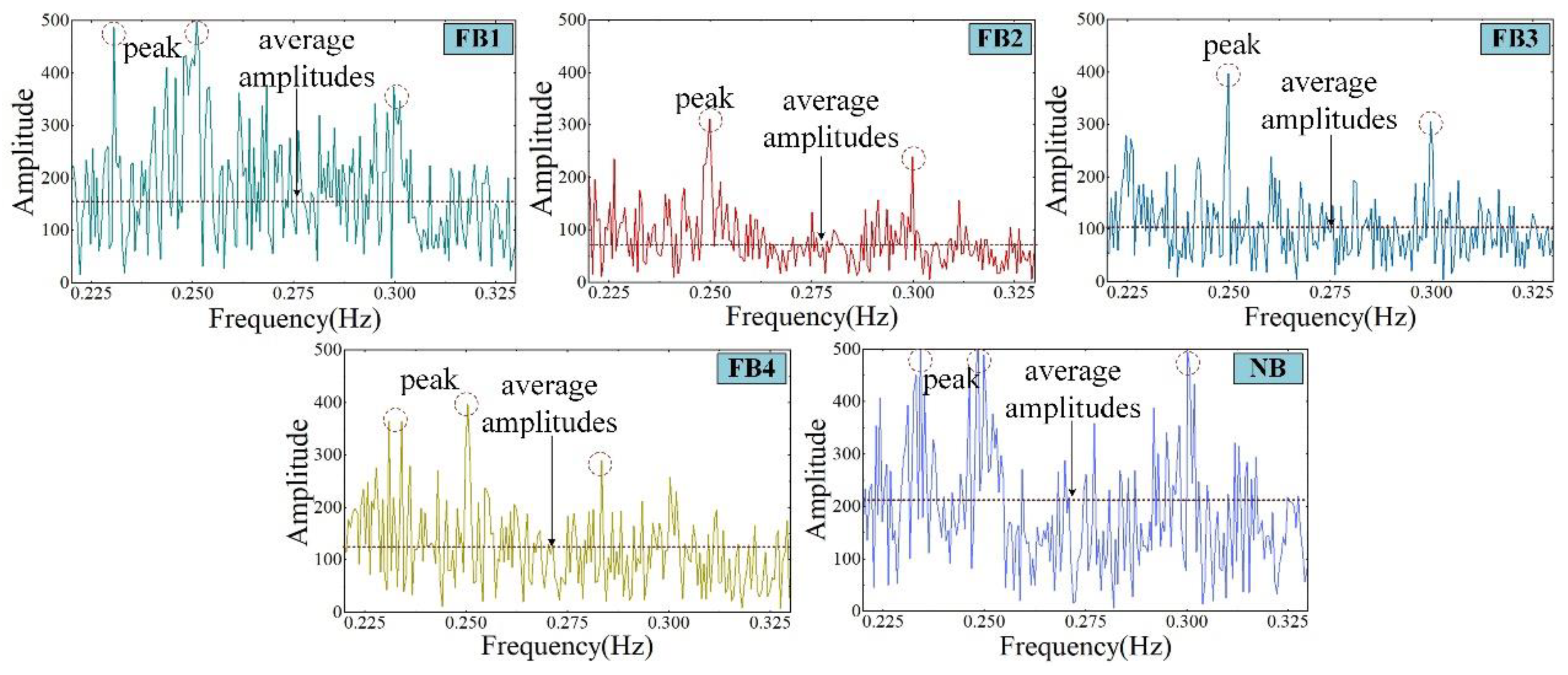

| Density | Impact Energy | Hardness | Bending Strength |
|---|---|---|---|
| g/cm3 | J/cm2 | HRA | MPa |
| 14.6–14.9 | 2.5 | 89 | 1500 |
| Element | Cr | Fe | Si | Mn | Cu | Mg | Zn | Ti | Other | Al |
|---|---|---|---|---|---|---|---|---|---|---|
| wt% | 0.18–0.28 | 0.5 | 23.6 | 0.3 | 1.2–2.0 | 2.1–2.9 | 5.1–6.1 | 0.2 | 0.15 | bal |
| Yield Strength | Tensile Strength | Elongation Ratio | Density | Hardness | Melting Point |
|---|---|---|---|---|---|
| (%) | (g/cm3) | (HRC) | |||
| 503 | 572 | 11 | 2.82 | 150 | 475–635 |
| Voltage | Time | Distance | Fiber Length | Fiber Diameter |
|---|---|---|---|---|
| (V) | (s) | (mm) | (mm) | (µm) |
| 120 | 600 | 30 | 0.8 | 8 |
| Tool Type | Size of Geometries (mm) | ||
|---|---|---|---|
| L | |||
| FB1 | 3 | 13 | 0 |
| FB2 | 3 | 1.86 | 1.86 |
| FB3 | 3 | 2.6 | 2.6 |
| FB4 | 3 | 4.33 | 4.33 |
| NB | 3 | 0 | 0 |
| Broaching Speed | Broaching Depth | Broaching Stroke |
|---|---|---|
| (mm/s) | (mm) | (mm) |
| 20 | 0.05 | 40 |
| 40 | 0.05 | 40 |
| 60 | 0.05 | 40 |
Publisher’s Note: MDPI stays neutral with regard to jurisdictional claims in published maps and institutional affiliations. |
© 2022 by the authors. Licensee MDPI, Basel, Switzerland. This article is an open access article distributed under the terms and conditions of the Creative Commons Attribution (CC BY) license (https://creativecommons.org/licenses/by/4.0/).
Share and Cite
Ni, J.; Zhang, H.; Feng, K.; Zhao, H. Assessment of a Bionic Broach Implanted with Nylon Fibers. Materials 2022, 15, 9040. https://doi.org/10.3390/ma15249040
Ni J, Zhang H, Feng K, Zhao H. Assessment of a Bionic Broach Implanted with Nylon Fibers. Materials. 2022; 15(24):9040. https://doi.org/10.3390/ma15249040
Chicago/Turabian StyleNi, Jing, Haohan Zhang, Kai Feng, and Huijun Zhao. 2022. "Assessment of a Bionic Broach Implanted with Nylon Fibers" Materials 15, no. 24: 9040. https://doi.org/10.3390/ma15249040
APA StyleNi, J., Zhang, H., Feng, K., & Zhao, H. (2022). Assessment of a Bionic Broach Implanted with Nylon Fibers. Materials, 15(24), 9040. https://doi.org/10.3390/ma15249040





